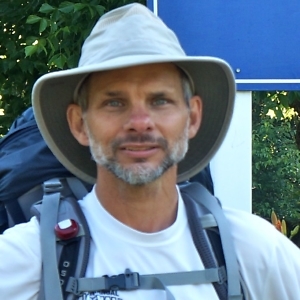Dodging Cars and History
S.J. Dahlman traces Daniel Boone’s Wilderness Road through modern Appalachia
Months after his wife’s slow death from Huntington’s disease, S.J. Dahlman, a journalist and professor at Milligan College, decided to retrace the nearly 300-mile length of Daniel Boone’s Wilderness Road on foot. Despite never having done any significant hiking or camping, he set out from Sycamore Shoals, near his home in Johnson City, and arrived weeks later at Fort Boonesborough, Kentucky. A Familiar Wilderness: Searching for Home on Daniel Boone’s Road is his account of the journey.
 The book’s subtitle neatly summarizes Dahlman’s reasons for the trip. Having grown up in New York and Florida before traveling widely, including five years as a minister in England, he wanted to better understand his adopted home of Tennessee, where he had always felt himself an outsider since moving here in 1998.
The book’s subtitle neatly summarizes Dahlman’s reasons for the trip. Having grown up in New York and Florida before traveling widely, including five years as a minister in England, he wanted to better understand his adopted home of Tennessee, where he had always felt himself an outsider since moving here in 1998.
More than that, Dahlman was also looking for “home” in a national sense, writing of the Wilderness Road, “I wondered if it was not only an artifact of America’s past, but also a lens for viewing the present.” Boone’s 1775 trailblazing effort, funded by an over-reaching real estate developer, eventually carried thousands of settlers into Tennessee, Kentucky, and the Ohio valley, launching a westward expansion that continued unabated for over a century. The frontier mentality this expansion engendered now seems an indelible part of the American character. To seek its roots, A Familiar Wilderness mixes history, travel writing, and personal reflection.
Dahlman’s literary trek puts him in heady company. At least two great contemporary works of nonfiction are built around the accounts of inexperienced hikers making epic journeys on foot through American wilderness: Bill Bryson’s comic 1998 masterpiece A Walk in the Woods, in which a middle-aged writer and his overweight friend tackle the Appalachian Trial, and Cheryl Strayed’s Wild, a moving 2012 memoir of the author’s 1,000-mile walk on the Pacific Crest Trail while confronting personal loss. But while Bryson and Strayed gain their insights through interactions with nature, Dahlman finds Boone’s wilderness radically transformed. It is indeed “familiar,” but natural? Not so much.
 Dahlman encounters communities that Boone helped establish, tours reconstructions of forts he occupied, and even meets direct descendants of the famed outdoorsman, but the landscape he travels is a mix of busy highways and rural roads dotted with farms, trailer parks, strip malls, occasional mini-mansions, and some (generally lackluster) industry. Travelers on Boone’s original trail risked many ways to be killed — the foremost being attacks by Native Americans who disagreed with the notion that their land had been “sold” to a developer. But the greatest risk Dahlman faces is a very real threat of being run over by cars or 18-wheelers as he hikes along littered highway shoulders, stepping over occasional roadkill.
Dahlman encounters communities that Boone helped establish, tours reconstructions of forts he occupied, and even meets direct descendants of the famed outdoorsman, but the landscape he travels is a mix of busy highways and rural roads dotted with farms, trailer parks, strip malls, occasional mini-mansions, and some (generally lackluster) industry. Travelers on Boone’s original trail risked many ways to be killed — the foremost being attacks by Native Americans who disagreed with the notion that their land had been “sold” to a developer. But the greatest risk Dahlman faces is a very real threat of being run over by cars or 18-wheelers as he hikes along littered highway shoulders, stepping over occasional roadkill.
This sadly domesticated terrain — populated by retirees, artisan weavers, and opioid-addicted former coal miners — becomes Dahlman’s true destination. As he follows Boone’s footsteps, the journey becomes less of a nature tale and something more akin to a narrative road trip, reminiscent of William Least Heat Moon’s Blue Highways. The land’s history and the people he finds along the path prove far more interesting than the fact he happens to be walking upon it. Many chapters of A Familiar Wilderness contain Dahlman’s candid photographs of these strangers, along with short yet often surprisingly moving accounts of their lives.
He is struck, for example, by the artistic and woodcraft skills he observes in Wes Dingus, a 33-year-old man living on a small disability check since a horse kicked him in the head at 17. “He was bright and inquisitive,” Dahlman observes, “the possessor of a trove of Cherokee knowledge, a man who summoned words like ‘iridescent’ and ‘metaphor’ and noticed how hatchlings would imprint on him.” In the end, the meeting reminds Dahlman that “it does not take much to alter the trajectory of a life. A horse’s hoof. An icy riverbank. A renegade gene.”
By the time Dahlman reaches the end of his Appalachian walkabout — at Kentucky’s Fort Boonesborough State Park, where he is met by friends and family — it is clear that the journey has changed the trajectory of his own life. For readers living, whether by birth or migration, within the landscape that Boone’s Wilderness Road opened to the modern world, A Familiar Wilderness provides an engaging and close-up exploration of what it once was, how it became what it is today, and what it can mean to a 21st-century explorer.
Michael Ray Taylor chairs the communication and theatre arts department at Henderson State University in Arkadelphia, Arkansas. He is working on a book about Tennessee caves and cavers.


